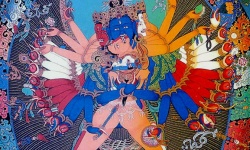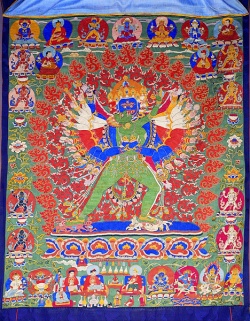Kalacakra is a yidam
Kalacakra is a yidam who has become quite well known in Tibetan Buddhist circles in the West. This is because a number of lamas have given mass initiations into his practice. The Dalai Lama has given Kalacakra initiations attended by thousands of people in a number of places in Europe and America, as well as in India. In consequence, several books on the Kalacakra system are now available in the West.
This practice of giving mass initiation for a yidam of Highest Tantra is very uncommon, and gives Kalacakra a peculiar significance for the Tantric tradition.
In a way, the initiation is regarded as more general, and the commitments one takes are not seen as being as serious as those for other Highest Tantra initiations. The Tibetans consider that, while of course one should make every effort to take the initiation and the commitments seriously, the act of simply attending and participating will be beneficial.
The initiation will plant seeds of a positive nature in one's mind which, if tended, can ripen at a later date as catalysts of spiritual progress.
These initiations then take on the significance of large festive occasions, auspicious for all those who attend them in good faith.
Kalacakra (Tibetan Du Kyi Khorlo, sometimes abbreviated to Dukhor) means 'wheel of time', and time is one of the central concerns of the Kalacakra system.
Especially in the commentaries on this tantra there is a great deal of discussion of time and transcending time - as the experience of Enlightenment transcends time and space. In general, this system of Tantric practice uses a developed view of time to arrive at the Timeless.
It is usually classified as a Mother Tantra, and both deity and tantra are highly regarded by all Tibetan schools.
It is an exceedingly complex system of thought and practice, which has outer, inner, and secret levels. The outer teachings of Kalacakra are concerned with astronomy, astrology, and mathematics.
The secret teachings are the actual instructions for meditating on the Kalacakra mandala.
According to tradition, the Kalacakra Tantra was proclaimed by the Buddha, himself appearing in the form of Kalacakra a year after his Enlightenment. 55
He taught the Tantra at Dhanyakataka in southern India, inside a huge stupa, at the request of King Sucandra.
Sucandra was king of Shambhala - a legendary country to the north-east of India.
The king returned to Shambhala, built a three-dimensional mandala of Kalacakra, and made Tantric Buddhism based on the Kalacakra system the state ;religion. The Kalacakra teachings were propagated in Shambala by a line of kings.
The eighth, Manjusrikirti, initiated many people into the Tantra, and also composed a short text - the 'Condensed Kalacakra Tantra' - which is what is now ;generally known as the Kalacakra Tantra.
In consequence he became known as Kulika (one who bears the lineage).
According to tradition, the Kalacakra teachings are still being propagated in Shambala by the Kulika kings.
An Indian master from Orissa called Cilupa is said to have travelled to Shambala and returned with Kalacakra teachings, which were subsequently passed on to Naropa and then to Atisa.
- The fact that there is no trace of the Tantra in India before Cilupa has led some scholars to suggest that the Tantra originated somewhere in central Asia.
The Kalacakra teachings came to Tibet with Atisa in 1026.
Their introduction into Tibet led to a new system of measuring time in sixty-year periods.
Five elements;
<poem>
fire,
earth,
water,
wood, and
metal,
were added to the twelve-year system by which each year is attributed to one of the signs of the zodiac.
- The Kalacakra system was studied by all schools of Tibetan Buddhism.
It was propagated by the great Sakyapa lamas Sakya Pandita and Phakpa. Tsongkhapa, the founder of the Geluk order, wrote several short works on it, and his two main disciples both wrote extensive commentaries.
- To achieve a clear visualization of the most complex mandala of Kalacakra would be a meditative tour deforce.
- One would have to become, in meditation, a four-faced male deity with consort, standing on the figures of Kamadeva (the Indian god of love) and Rudra.
Two goddesses, the consorts of the subjugated gods, hold on to Kalacakra's heels, their heads bowed.
The yab is blue, and has six shoulders, twelve upper arms, and twenty four lower arms. The lower arms are arranged in three sets of four on each side, each set of a different colour.
- The uppermost set on each side is white, the middle red, the lower blue.
- Each of his arms holds a symbolic implement, such as a sword, a wheel, or an axe.
- Even his fingers are of different colours.
- As Kalacakra one would embrace the consort Visvamata (mother of all).
- She is yellow in colour, with four faces and eight arms.
- She holds a curved knife, an iron hook, a damaru, and a rosary in her right hands, and a skull, a noose, a white lotus, and a jewel in her left.
One would see oneself standing in the middle of a glorious palace at the center of a five levelled mandala-palace, surrounded by a radiating pattern of hundreds of figures.56 The yidam and his mandala fuse time and the Timeless, the 'endless round' and absolute Reality, into one non-dual vision in which neither polarity is suppressed.
Perhaps one day we shall see Western tantras produced which combine our knowledge of astronomy and other sciences with the profound Enlightened viewpoint of the Buddha. What extraordinary figures, what marvellous mandalas, could such a vision produce! </poem>

